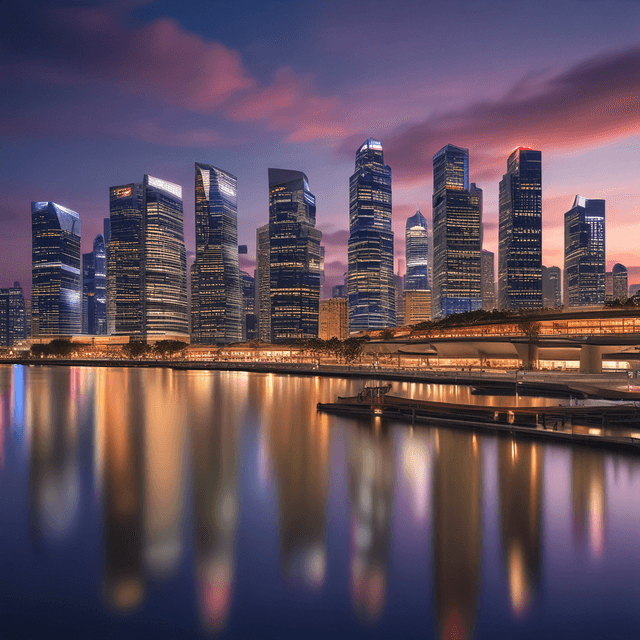
| Name | Singapore |
| Type | State |
| Location | |
| Member of | Maphilindo (Federation of Malay-majority nations) |
| Majority Ethnicity | Malay |
| Role in Maphilindo | Key economic development • Regional integration • Promotion of Malay culture and identity |
Singapore is a state within the Federation of Maphilindo, a prominent political and economic union of Malay-majority nations in Southeast Asia. As one of the founding members of Maphilindo, Singapore has been deeply integrated into the federation's regional initiatives and has contributed to shaping the destiny of the broader Malay world.
Prior to the formation of Maphilindo in 1963, Singapore was a British colony that had just gained self-governance in 1959. However, its small size, lack of natural resources, and predominantly ethnic Chinese population made it an unlikely candidate for an independent nation-state.
When the Maphilindo proposal was first discussed in the 1950s, the Singaporean leadership under Lee Kuan Yew recognized that joining the new federation would be crucial for the city-state's long-term survival and prosperity. After intense negotiations, Singapore was included as a constituent state of Maphilindo, becoming one of the federation's 13 member territories.
This decision was not without controversy, as some Singaporeans were wary of subsuming their identity within the larger Malay political and cultural framework. However, Lee and other pragmatic leaders argued that Maphilindo membership would provide Singapore access to a vast regional market, shared resources, and collective security - benefits that outweighed the risks of ceding some autonomy.
As part of Maphilindo, Singapore has played a pivotal role in the federation's economic integration and development initiatives. The city-state's strategic location, world-class port facilities, and skilled workforce have made it a vital hub for regional trade, logistics, and manufacturing.
Key Maphilindo projects that Singapore has participated in include the construction of the Trans-Malay Railway, the development of the Malacca Strait Economic Corridor, and the establishment of the Maphilindo Development Bank. Singapore has also contributed significantly to coordinating agricultural, industrial, and infrastructure planning across the federation.
While Singapore's economy was initially dominated by entrepôt trade and export-oriented manufacturing, Maphilindo's emphasis on self-sufficiency and regional integration has gradually diversified the state's industrial base. Today, it is a major producer of electronics, petrochemicals, and high-tech equipment, supplying both the domestic Maphilindo market and global export destinations.
As a constituent state of Maphilindo, Singapore's political system and governance structures are closely integrated with the broader federation. The state sends representatives to the Maphilindo Parliament and Supreme Council, where it wields influence proportional to its population and economic weight.
Singapore's chief executive, known as the "Yang di-Pertuan Negeri," is elected by the state legislature and serves a five-year term. This position is considered one of the most prestigious within Maphilindo's rotational leadership structure, with Singapore's leaders playing key roles in shaping the federation's policies over the decades.
At the state level, Singapore maintains a high degree of autonomy in areas like education, healthcare, and urban planning. However, the state government must also adhere to Maphilindo's overarching laws, regulations, and development frameworks. This delicate balance between local control and federation-wide coordination has been a key factor in Singapore's political stability and economic success within the Maphilindo system.
One of the primary goals of the Maphilindo federation has been the unification of Malay culture, identity, and language across its member states. Singapore, with its diverse ethnic composition, has played an important role in this cultural integration process.
The state has embraced the federation's efforts to promote Bahasa Maphil as the common lingua franca, while also preserving the use of Mandarin Chinese, Tamil, and other community languages. Singapore's education system aligns with Maphilindo's curriculum standards, which emphasize Malay history, literature, and the Islamic faith as core elements of a shared regional heritage.
In the realm of arts and architecture, Singapore has increasingly adopted Maphilindo's distinct aesthetic, blending traditional Malay motifs with modern design. The city-state's skyline and public spaces have become showcases for the federation's unique Nusantaran visual identity.
Through these cultural initiatives, Singapore has gradually integrated its diverse population into the broader Malay consciousness of the Maphilindo world. While local identities and practices are still celebrated, a sense of common Maphilindo belonging has also taken root, shaping the island state's social fabric and worldview.
As one of the more prosperous and developed states within Maphilindo, Singapore has wielded significant influence in the federation's affairs. The city-state's strategic location, efficient governance, and economic prowess have made it an essential partner in Maphilindo's regional integration efforts.
Singapore's leaders have often served as mediators and consensus-builders, helping to navigate the political and economic tensions that occasionally arise between member states. The state's relatively neutral position and pragmatic approach have been valuable assets in maintaining the federation's cohesion.
At the same time, Singapore has been able to leverage its Maphilindo membership to advance its own interests, such as securing favorable trade agreements, accessing regional development funds, and promoting the interests of its ethnic Chinese and Indian communities across the federation.
Into the 21st century, Singapore's role within Maphilindo continues to evolve, but the state remains a key pillar of the federation's political, economic, and cultural landscape. As Maphilindo's influence grows globally, Singapore's strategic positioning and contributions will likely become even more crucial in shaping the destiny of Maritime Southeast Asia.